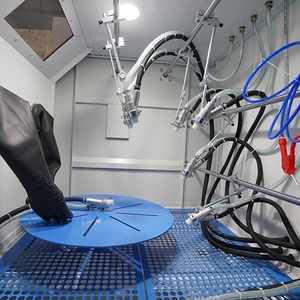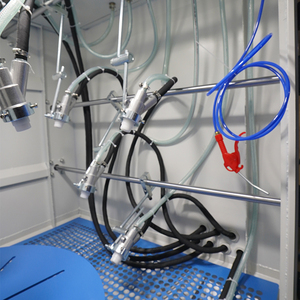
All categories
Featured selections
Trade Assurance
Buyer Central
Help Center
Get the app
Become a supplier

(4345 products available)




























A sand blasting light is an essential tool for sandblasting. It helps workers to see clearly in the sandblasting area. There are different types of sand blasting lights. Here are some of them:
LED Sand Blasting Lights
These lights have a reputation for their energy efficiency and long lifespan. They emit a bright white light. This light creates a clear view of the sandblasting area. Most of them have a high durability feature. This is because they are built with materials that can resist high temperatures and impacts. They can be used in different sandblasting environments. For instance, closed blasting cabinets and open blasting pots.
Halogen Sand Blasting Lights
These lights are popular due to their high-intensity illumination. They produce a very bright light. This makes them suitable for use in environments that have high levels of dust and darkness. Halogen lights provide a warm light. This makes them favorable in colder environments where additional heat is required.
Xenon Sand Blasting Lights
Xenons are known for producing a very bright and efficient light beam. Their lights have a high visibility feature. This makes them suitable for challenging conditions. They are mostly used in situations that require a high level of illumination. For example, large-scale sandblasting projects.
Fluorescent Sand Blasting Lights
These lights are known for their energy efficiency. They are used in environments where long working hours are needed. They provide uniform light distribution to reduce shadows and improve visibility. This makes them favorable for detailed sandblasting tasks.
Portable Sand Blasting Lights
These lights are lightweight and come with a compact design. They are easy to move from one place to another. They are powered by batteries. This eliminates the need for electric cords which can be restrictive. They are used in remote locations where there is no electricity. These lights improve the work efficiency of sandblasting. They are used in both small and large sandblasting projects.
There are many features of a sandblasting light that help improve its performance. Here are some of the key features and their functions:
LED Technology
Sand blasting lights often use LEDs. These lights are known for their brightness. They also use less energy. The lights have long lives. They can last up to 50,000 hours. These lights produce a focused beam. The beam is bright. It helps workers see the blasting area well. This makes them do their work more accurately.
High Intensity
A sand blasting light needs to be very bright. This is to illuminate large areas. It needs to illuminate areas well. This is even in the presence of ambient lighting. An intense light improves visibility. This helps workers to do their blasting tasks safely and accurately.
Adjustable Arm
Most sand blasting lights have adjustable arms. The arms are flexible. They can be positioned in various ways. They allow the light to be directed where it's needed. This improves visibility in different areas.
Dimming Options
Some blasting lights have dimming options. They allow users to change the brightness level. This is to suit the lighting needs of different tasks. Dimming lights can help reduce glare. This improves visibility.
Power Source
These lights can be powered differently. They can use AC power or DC power. Some lights have rechargeable batteries. This makes them portable. They can be moved and used in different areas.
Water and Dust Resistance
Sand blasting lights are made to be very strong. They have casings that protect the internal parts from water and dust. These lights are waterproof. They have a rating of IP65 or more. This means they can't be damaged when exposed to water. The lights are also dustproof. They can't be damaged by dust particles. This ensures the lights work well in the sand blasting environment.
Magnetic Base
Some sand blasting lights have a magnetic base. This allows them to be easily attached to metal surfaces. The magnetic base gives them a strong and stable support. It allows for quick repositioning of the lights when needed.
There are various applications of sand blasting lights, including;
There are many options for sand blasting lights in terms of size, power, and material. Therefore, it is essential to determine the needs before purchasing the lights. Here are some factors to consider when choosing the right blasting light.
IP RATING
The first thing to check is the IP rating, which shows the light's resistance to dust and water. The rating will show two numbers, like 67. The first six shows the level of protection from dust particles, and the second shows the water resistance level. When choosing a light, select one with at least IP67. The first number should be 6, which means the light is dustproof. The second number should be 7 or more, which shows the light can stay under water for some minutes.
WORKING HOURS
Another important thing to check is the working hours. Working hours are the number of hours the light can work continuously. A good sand blasting light should have at least 500 working hours. The working hours will help buyers determine the cost of replacing the light.
VOLTAGE AND POWER
The voltage and power of the light should also be considered when choosing a blasting light. The voltage shows the electrical energy supplied to the light. It also influences the brightness. Most sand blasting light manufacturers provide a voltage chart to help customers choose the right voltage.
SIZE
The size of the light will also impact its performance. Get a light with a large size since it will produce a high-intensity beam. The size will also affect the beam's angle. A big size will have a beam angle of 90 degrees, while a small size will have an angle of 60 degrees.
HEAT DISSIPATION
Since the blasting light will be used for long hours, it is important to get a light that can dissipate heat. This is because most lights will overheat and stop working if it cannot dissipate heat. Buyers should choose a light with a heat-dissipating feature, like aluminum housing, which can dissipate heat effectively.
Q1: What are the safety precautions for sandblasting?
A1: Safety measures include wearing protective gear, using appropriate lighting, and following equipment guidelines. Users should also ensure a safe environment and proper sandblasting techniques.
Q2: What are the types of sandblasting lights?
A2: The main types of sandblasting lights are flood lights, LED work lights, and halogen lights.
Q3: How to maintain a sand blasting light?
A3: Proper maintenance involves regularly cleaning the light to remove dust and debris, checking for any damages, and ensuring the light is properly mounted and positioned.
Q4: Can sand blasting lights be used for other purposes?
A4: Yes, sand blasting lights can be used for various tasks, including outdoor lighting, inspection lighting, and project lighting. However, it is important to ensure the lights are compatible with the intended use.
Q5: Are there explosion-proof sand blasting lights?